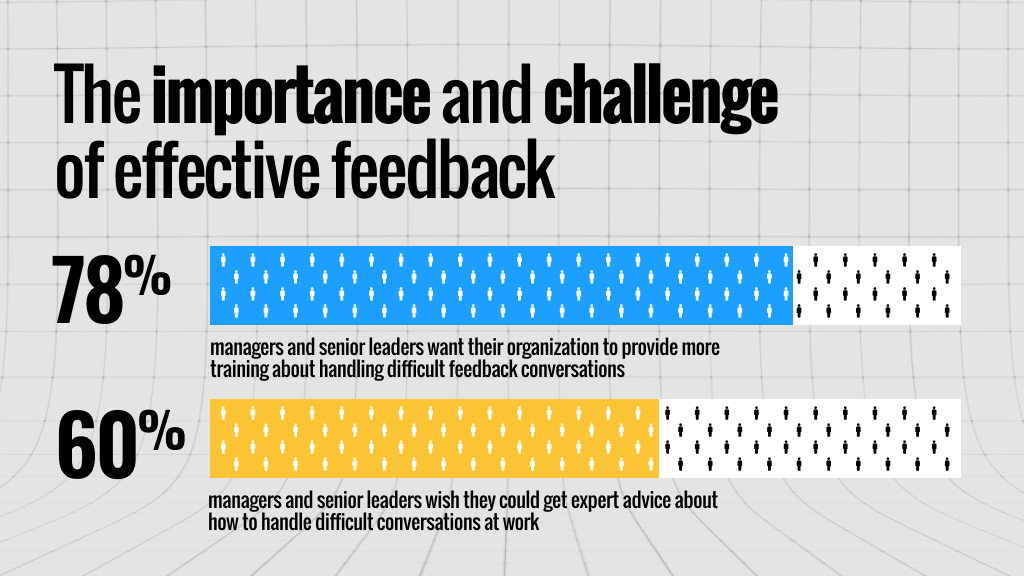Feedback fitness: How to cultivate this foundation of team growth

Search the business section of your favorite bookstore, and you’ll find plenty of titles focused on giving and receiving feedback. The sheer volume indicates that many leaders struggle over how to improve their skills in this area, and something is standing in their way.
For instance, if annual performance reviews are regarded as the primary feedback channel at an organization, leaders may default to process-driven interactions rather than make a habit of more frequent, informal, and immediate discussions.
More crucially, the ability to deliver meaningful feedback may be perceived as an inherent talent in a leader, rather than a skill that can be developed. As a consequence, leaders thrust into difficult conversations may feel ill-equipped to handle them, leading them to delay or avoid them altogether. Finally, such leaders may fail to grasp the value of positive feedback and neglect to take the time to recognize employee accomplishments and contributions.
What’s needed to help these leaders is an organizational culture that nurtures their “feedback fitness.” Like physical fitness, feedback fitness isn’t accomplished in a day of aggressively hard work. It requires dedication, a willingness to push personal limits, and a commitment to continuous improvement.
Here’s why it’s so important and what L&D professionals can do to help.
What employees think
In a BigThink+ survey of full-time US employees, the importance and challenges of delivering meaningful feedback were evident.
Of 288 managers and senior leaders surveyed, 86% agreed that regular and targeted feedback is essential for the growth of their team members. However, 78% wanted their organization to provide more training about handling difficult feedback conversations, and 60% said they wished they could get expert advice about how to handle difficult conversations at work.

Clearly, leaders believe feedback is critical for their teams, and they want to do it right. However, they need help.
The first step is recognizing that effective feedback is a social art, one that requires dedicated learning, practice, and ongoing skill development to master. Once that understanding is in place at a cultural level, L&D can begin helping leaders across the organization cultivate the best practices they need to succeed.
3 L&D strategies to build feedback fitness in your culture
Communicate what effective feedback looks like
Some leaders have observed and benefited from effective feedback throughout their careers. Others haven’t been as fortunate, and in the absence of clear expectations and role models, their feedback quality will likely be inconsistent at best.
While expectations should be communicated from the top of the organization, leaders and employees can readily take advantage of tangible guidance on what:
- Quality feedback looks like.
- Questions they can use during discussions.
- Strategies help ease negative feedback situations.
L&D is an excellent conduit to help relevant, compelling, and easy-to-use resources reach the populations where they are most needed.
Develop feedback competence
The need for feedback competence doesn’t reside solely with leaders. The ability and courage to engage in candid conversations are high-value skills across the board. However, developing those capabilities requires a multi-pronged approach.
Learning elements might include emotional intelligence education to help leaders and team members explore how their own emotional needs and triggers can influence feedback perspectives. Interpersonal skills training can enhance one-to-one communication skills, and scenario-based learning allows participants to practice for real-world situations in the safety of a controlled environment.
For on-the-job support, L&D can help leaders take advantage of just-in-time resources, such as guides for engaging in difficult feedback discussions or a refresher on effective feedback behaviors. An on-call coach who helps leaders prepare for and evaluate feedback situations can also add significant value.
Integrate feedback expectations into daily operations
Gallup research reveals that 80% of employees who say they have received meaningful feedback in the past week are fully engaged — and engaged employees improve organization performance. However, even leaders highly motivated to provide feedback can struggle to balance multiple expectations for their time. Providing feedback can easily take a back seat to other responsibilities unless it is continually reinforced and rewarded as “how we do business.”
Here again, L&D is integral to strengthening the organization’s dedication to a feedback culture through a combination of continued skill development, behavior modeling, reinforcement, and relevant measurement.
Final thoughts
Creating and sustaining a feedback fitness culture is a long-term commitment. Just as with physical fitness, misinformation, a lack of practice, and competing objectives can imperil progress.
Leaders must continually juggle numerous demands for their time and effort. Additionally, leadership teams are rarely static as positions change and new people enter the fold. L&D is uniquely positioned to provide the cohesion, clarity, and consistency to help ensure that feedback fitness remains a top priority throughout.




